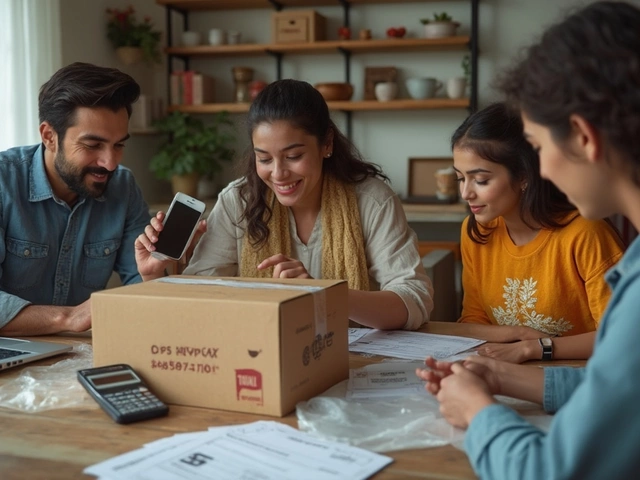Ever found yourself absolutely swamped, staring at a parcel that needs to go out, but you have zero time to get it to the post office? Maybe you’ve sold something bulky on eBay or are returning something heavy to a retailer, and lugging it across town isn’t happening. You’re not alone. Lots of people in the UK are turning to courier collection services as a way to skip the hassle of drop-off queues and make parcel-sending fit around their own schedules. It’s become so normal that Royal Mail, DPD, Evri, and dozens more now let you tap a few buttons and get a courier to rock up at your doorstep and whisk your parcel away, no matter whether you’re at home, work, or even your favourite café. Sounds good, right? But how does it actually work, what can you send, and what should you watch for? Let’s sort it out.
How Courier Collection Works & Why It’s Become a Go-To Option
Courier collection isn’t some technical wizardry or a service only for stores and businesses. You, me, or anyone can book it from pretty much anywhere in mainland UK. Here’s the basic run-down: you book a pickup online or through an app, a courier comes to wherever you choose, scans your parcel, and off it goes into their same-day or next-day network. It’s especially handy if you’re dealing with something heavy or weirdly shaped, or you just can’t stand juggling a pile of boxes on the bus (we’ve all been that person!).
What’s really interesting is how sharply demand for this has grown. According to figures from the Office for National Statistics, parcel volumes in the UK more than doubled between 2016 and 2024, and over half of all parcels handled by the big-name couriers are now collected rather than dropped off. It’s easy to see why: flexible pickup times, no queues, and often the same cost as drop-off services. In fact, last year, a YouGov survey found 62% of UK parcel senders preferred to book a courier collection if the price is the same.
Most courier companies now offer collections for both home and business users. Royal Mail’s ‘Parcel Collect’ or DPD’s ‘Pickup’ feature, for example, let you book a courier to arrive the very same or next day. You enter a few details, pay online, print your label (sometimes the courier brings it), then get a specific timeslot, so you aren’t stuck waiting all day. It’s dead simple. But there are some quirks to watch for. Some services do require you to print your own labels, and a few charge slightly more for collection – typically just a quid or so extra. If you’re using a third-party service like Parcel2Go or Shiply, you’ll often get quotes from multiple couriers, including small local firms who might be more flexible if you’ve got trickier logistics (like needing evening pickups or sending something especially valuable).
If you’re worried about reliability or past horror stories about lost parcels, keep in mind that almost all big courier collections include door-to-door tracking, proof of collection, and a photo for extra security. Some, like DPD, even text you a live tracking link as soon as your parcel’s scanned. If you need that extra peace of mind, you can add basic insurance for a pound or two more – particularly useful if you’re sending gadgets or pricey gear.
All in, arranging a courier to collect your parcel isn’t just some luxury for businesses. It’s basically become a default way to send stuff in the post-pandemic UK, especially if you’re working odd hours, stuck at home, or sending something a bit awkward. But there’s no ‘one size fits all’ here – finding the right courier and service for your parcel can save you time, money, and a whole lot of stress. Let's get into the details of booking a pickup, what couriers will collect, and a few practical tips to make it all painless.
Types of Parcels Couriers Will Collect & What Rules to Know
So you’ve got a parcel, but can you just hand over anything to a courier? The answer is a bit of ‘it depends’. Most UK couriers are set up to collect almost anything you’d post, but there are a few catches and a few types of items that always trigger more questions.
For regular personal parcels—think books, clothes, shoes, tech, or paperwork—almost every big-name and local courier will grab them from wherever you choose. With business or e-commerce sellers, couriers will usually pick up big bundles of parcels together, but they’re just as happy to haul off a single item for regular folks. Even awkward shapes, like musical instruments or sports gear, are usually fine as long as you measure and weigh them accurately. DPD, for example, will take parcels up to 30kg and up to 1m in length, while Royal Mail will accept small, medium, or large sizes, though oversized items get pricier and might need to be booked as a special service.
There are, however, prohibited and restricted items. Every courier has its own specific list, but the biggies to watch out for are:
- Dangerous goods (like batteries not installed in devices, paint, or flammable liquids)
- Cash or valuable jewelry over a certain limit
- Perishable food (unless specially packed and agreed in advance)
- Weapons, including replicas, and fireworks
- Live animals or insects
- Alcohol (sometimes allowed with age verification, depending on the company)
Some platforms help you check automatically during booking—just search for ‘prohibited items’ on their FAQ pages, or look for an item checker widget. If you’re sending within the UK, you’ll have fewer restrictions than international, but if you’re in doubt, just ask your courier before you book to avoid delays or, worse, the parcel being destroyed or returned at your expense.
Now, about packaging. Don’t overlook this step; it really matters. Couriers won’t collect totally unwrapped items or things shoved in shopping bags. Your stuff needs to be packed securely in a box or padded envelope, with the address and return label clearly visible. If you want to be double safe, take photo proof with your phone of the parcel before it leaves your hands. Some couriers will refuse to take parcels if they look dodgy or are leaking or damaged.
And when it comes to heavy or large parcels, be honest about the size and weight during booking – many drivers travel alone, so if they turn up expecting a 2kg package and find a 20kg box, they may have to refuse on the spot, leading to an annoying rebooking. If your parcel is massive, let the courier know in advance – a lot of them offer two-person pickups for very heavy items, but you might need to book a day ahead.
Steps to Book a Courier Collection—From Sign-up to Tracking
So, you're ready to book a courier to collect your parcel? Here's the typical step-by-step process, along with some advice that makes it easier and avoids common pitfalls.
- Choose a courier or platform. Decide if you want to go direct with Royal Mail, DPD, Evri, Yodel, or use an online comparison tool like ParcelHero or Parcel2Go. The aggregator sites can be handy as they often give you several quotes and let you see the different collection windows and insurance options all in one go.
- Enter addresses and parcel details. You’ll need the collection address (which could be your house, workplace, or sometimes even a neighbour’s), destination address, parcel size, and weight. Measure it honestly; drivers don’t love surprises. Here’s a quick size guide table for reference:
| Courier | Max Weight | Max Length |
|---|---|---|
| Royal Mail | 20kg | 90cm |
| DPD | 30kg | 100cm |
| Evri | 15kg | 120cm |
| Yodel | 25kg | 120cm |
- Pick a collection date and time window. Most couriers offer next-day or even same-day pickup. You’ll usually get a two-hour or even a one-hour slot on the morning of collection, so you don’t waste your whole day waiting. Certain services let you book late-evening pickups or select Saturdays, which is especially useful if you work 9-5.
- Decide on extras. Consider adding insurance, especially if you’re shipping electronics or collectibles. Some platforms let you boost coverage up to £2,500 or more for a small extra fee. Also decide if you want tracking updates by SMS or email – always a good idea for peace of mind.
- Print your label… or not. With some couriers (Evri and DPD included), you can choose services where the driver brings the label and sticks it on your box at the door, which is brilliant if you don’t have a printer. If you do need to print yourself, get it done the night before—low ink and jammed paper trays are the top reasons for failed collections!
- Prepare the parcel. Pack it well, tape it up, whack the label on, and have it ready for your collection window. Pro tip: write your phone number on the box—if there’s a hiccup, the driver can call you on the spot. If you live in a tricky-to-find spot (back alley flats, anyone?), add some “how to find us” instructions.
- Hand over and get proof. When the courier arrives, they’ll scan your parcel and give you a confirmation code, a signed receipt, or sometimes a photo as evidence it’s left your care. Keep this safe until you see the parcel’s been delivered to the recipient.
- Track online. Almost all modern courier services include real-time tracking. You can watch your parcel hit every depot, see out-for-delivery updates, and get alerts when it’s signed-for at the other end. If anything goes south (delays or failed delivery attempts), you can use the tracking to chase up customer support quickly.
Booking a courier collection really does move the headache out of your day. The trick is knowing the chain of steps and being organised ahead of time, especially if you’re sending something time-sensitive.
Real-World Tips: Getting the Most Out of Courier Collection Services
Now, if you’re asking if a courier can collect a parcel for me, the process doesn’t have to be a pain at all. People do worry about stuff like missed pickups, lost parcels, or not having a printer, but you can cover most of these worries with a bit of pre-planning.
- Double check the pickup time window: If you’re not going to be in, check if the courier will collect from a safe place (shed, porch, neighbour, office reception, etc.). Some drivers are more flexible than others—Royal Mail and DPD tend to be happy with instructions, while Yodel and Evri like clear handovers for insurance reasons.
- Group parcels: If you have multiple items to send, book them as a batch. Many couriers give discounts for collecting several at once and only charge a single collection fee (sometimes none at all).
- Take a photo before handover: Not just for proof, but as backup in case there are disputes later about damage or missing items.
- Use third-party platforms for deals: Sites like Parcel2Go or ParcelCompare sometimes have special rates lower than you’d get booking direct, especially for bulk shipments or odd shapes.
- Check for package drop trials: Some couriers now do trials of drone pick-up, robot curbside collection, or electric van ‘green collection’ slots. If you want your delivery greener, look for these options when booking in big cities.
- If you’re returning retail goods: Loads of major UK retailers partner with 24-hour courier collection services, so you can book against your order number on their returns page and skip the hassle entirely.
Missing or failed collections are rare these days but do happen. Always have a backup plan—maybe another pick-up day or a trusted neighbour who can help out. If a collection fails, most couriers let you rebook for free, but you might have to jump into a live chat to trigger it quickly. The YouGov stats from earlier? Turns out, the number one complaint from senders is confusion over pickup windows—so clarity makes a big difference.
Also, don’t be shy about asking for information if you’re not sure. Couriers’ support teams are usually decent about rerouting, updating pickup addresses last-minute, or clarifying what they’ll accept (especially with high-value or fragile items). This flexibility is a big reason people keep coming back to these services, even when they could technically nip to a Post Office themselves.
So, yes, a courier can collect a parcel for you—and it’s likely easier, cheaper, and much less hassle than most people realise. With the right prep—choose the right service, pack well, label clearly, pick your collection window, and keep your proof—you can send out anything from trainers to guitars to teddy bears, all while barely moving off your sofa. These days, skipping the post office is just smart time management.





